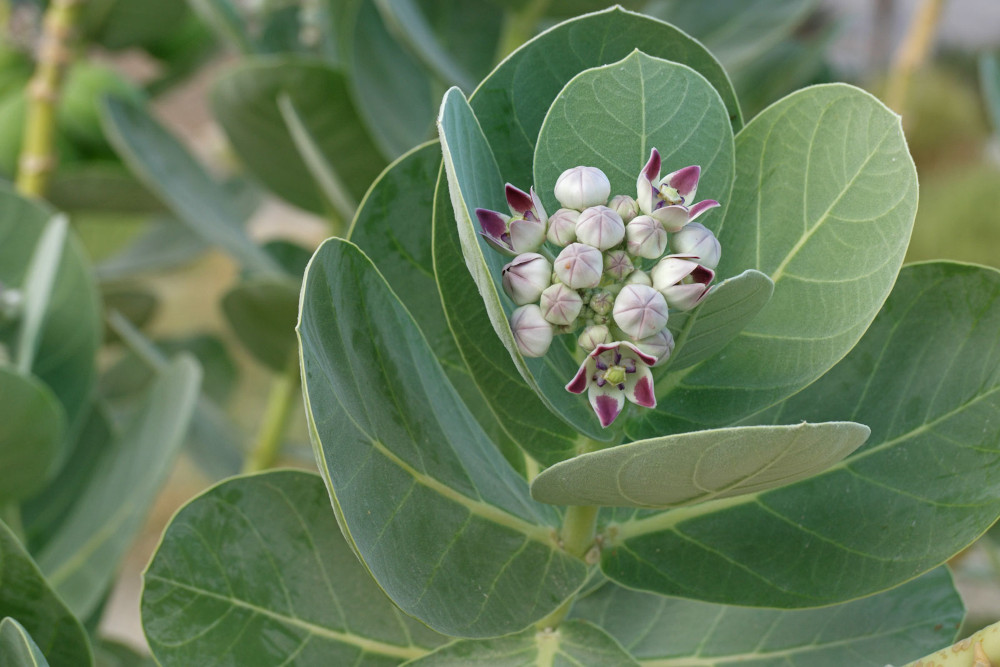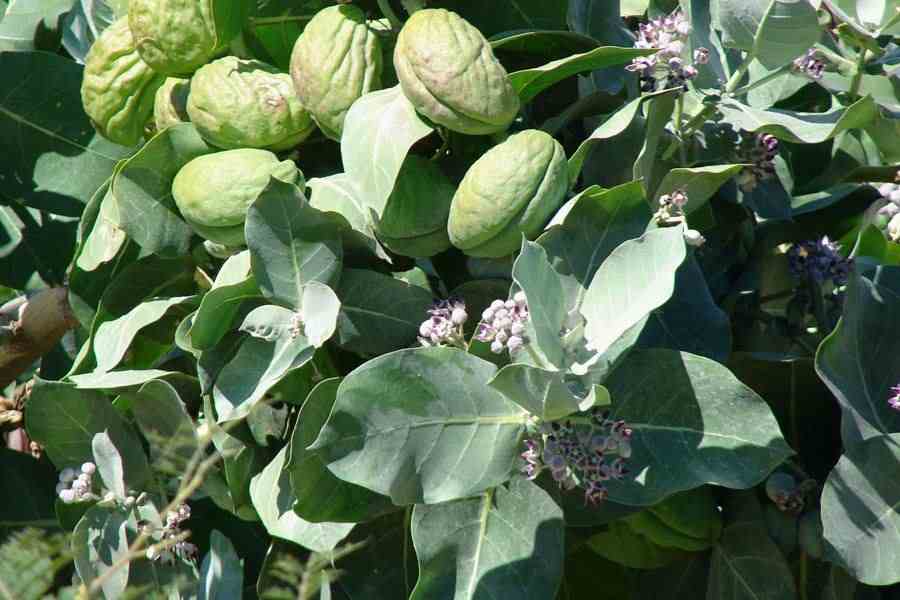Overview of Calotropis procera
Name: Apple of Sodom (Sodom’s Milkweed)
Latin Name: Calotropis procera
Other Names: Sodom Apple, Stabragh, Kapok Tree, King’s Crown, Rubber Bush, Rubber Tree, Calotropis, Auricula Tree, Cabbage Tree, Calotrope, Camel Tree, Dead Sea Fruit, Desert Wick, French Cotton, Giant Milkweed, Indian Milkweed, Mudar Fiber, Mudar Plant, Rooster Tree, Sodom’s Milkweed and Swallow-wort.
Habitat: North Africa, Tropical Africa, Western Asia, South Asia, and Indochina
Description of Calotropis procera
The plant is green throughout the year and has green hollow globes, but the flesh contains a milky sap that is extremely bitter and turns into a gluey coating resistant to soap. The fruits are green, turn to light yellow, and dry upon maturity and fruiting takes place throughout the year. The fruit contains numerous seeds, which are light, flat, brown, and attached to long white silky hair or pappus at one end that help the seeds to fly from one place to another spreading the plant.
Taste: Bitter, salty, Astringent

Action – Calotropis procera
Health benefits: Cure of leprosy and elephantiasis, asthma and catarrh, treats whooping cough, dysentery, headache, lice treatment, jaundice, sore gums and mouth. The plant has however been attributed a number of actions including:
Abortifacient, alterative; Antiaggregant, antibacterial, anticancer, antifeedant, antifertility, antiimplantation, anti-inflammatory, antiodontalgic, antisialagogue, antispasmodic, antisyphilitic, anti-tumor, aperitif, aphrodisiac, candidicide, cardiodepressant, cardio-tonic, carminative, contraceptive, dentifrice, depilatory, dermatitigenic, diaphoretic, digestive, diuretic, emetic, expectorant, fibrinolytic, fungicide, hypertensive, inebriant, infanticide, insecticide, lactagogue, larvicide, laxative, ovicide, pediculicide, piscicide, poison, proteolytic, respirastimulant, rubefacient, stimulant, stomachic, tonic, and vermifuge.
Indication – Calotropis procera
The plant is indicated for anorexia, asthma, bacteria, bite, boil, cancer, cancer of the abdomen, cancer of the colon, cancer of the epidermis, cancer of the nose, cancer of the pharynx, candida, caries, catarrh, childbirth, cholera, cold, constipation, convulsion, cough, cramp, dermatosis, diarrhea, dysentery, dyspepsia, earache, elephantiasis, epilepsy, fever, fit, fungus, gas, gonorrhea, gout, guinea worm, headache, hemorrhoid, hysteria, impotence, indigestion, infection, inflammation, leprosy, lice, low blood pressure, lupus, malaria, migraine, mycosis, ophthalmia, pain, rheumatism, rhinosis, salmonella, shigella, snakebite, sore, sprain ,stomachache, swelling, syphilis, toothache, tumor, ulcerous tumor, wart, water retention, worm, wound, and yaw.
Parts Uses
Leaves: To cure leucoderma (skin disease), antidote as rabies, to prompt healing, applied for poultice, to treat migraine, to treat fever, eczema, leprosy, elephantiasis, asthma, cough and rheumatism etc. (Anis et al., 2000;
Ahmad and Beg, 2001; Shah et al., 2006; Joshua, 2006;Bhogonkar and Kadam, 2007; Ready, 2008; Bhatt et al., 2009). N.B. The leaves are smoked to cure asthma and cough.
Flower: Skin infection gum treatment used in dysentery and antidote of scorpion (Abhishek et al., 2010; Kumar, 2009; Khan and Kamran, 2006)
Root: Used as digestive to treat body pain, malaria, eczema, leprosy elephantiasis, asthma, cough and rheumatism (Kumar, 2009; Sen and Behra, 2007; Showkat, 2007)
Latex: The latex is commonly used for ringworm, dog bitten wounds, and skin diseases.
Dosages
200–600 mg bark as a diaphoretic and expectorant, 2–4 g as emetic.
Contraindications, Interactions, and Side Effects
Hazards and/or side effects not known for proper therapeutic dosages. Very high doses may cause death, following bradycardia, convulsion, diarrhea, and vomiting. Can cause convulsion, diarrhea, vomiting, slowed but stronger heartbeat, labored respiration, increased blood pressure, and possible death. Traditional use in India may cause severe bullous dermatosis, leading occasionally to hypertropic scars. Contains cardioactive carde-nolides. In vitro calotropin inhibits human epidermoid carcinoma (nasopharynx). Most references say this has the same activities as C. gigantea.
Research papers on Calotropis procera
[embeddoc url=”https://italisvital.info/wp-content/uploads/2022/06/G0424257_CALOTROPIS_PROCERA.pdf”]
Calotropis procera: An Overview Of Its Phytochemistry And Pharmacology
Calotropis procera – An Ethnopharmacological Update – Amit et al., ARPB; Vol 2(II) (Review Article)
Calotropis procera: An Overview – Alok Pal Jain et al.
References
Handbook of Medicinal Herbs – Second Edition by James A. Duke with Mary Jo Bogenschutz-Godwin, Judi duCellier, Peggy-Ann K. Duke
Chapter 26 – The Potential of Sodom Apple (Calotropis procera and Calotropis gigantea) Seed Oil by Abdalbasit Adam Mariod Mohamed Elwathig Saeed Mirghani Ismail Hussein
A Review On CALOTROPIS PROCERA Its Phytochemistry And Traditional Uses by Hina Batool, Mumtaz Hussaina, Mansoor Hameeda, Rashid Ahmad
This article is copyrighted by Ital is Vital, 2024. Want to re-post this article? Visit our guidelines.
DISCLAIMER: THIS WEBSITE DOES NOT PROVIDE MEDICAL ADVICE
The information, including but not limited to, text, graphics, images and other material contained on this website are for informational purposes only. The purpose of this website is to promote broad consumer understanding and knowledge of various health topics. It is not intended to be a substitute for professional medical advice, diagnosis or treatment. Always seek the advice of your physician or other qualified health care provider with any questions you may have regarding a medical condition or treatment and before undertaking a new health care regimen, and never disregard professional medical advice or delay in seeking it because of something you have read on this website.
